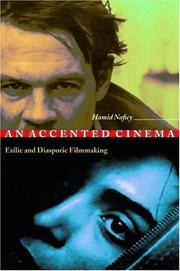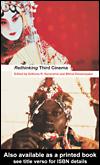| Listing 1 - 10 of 14 | << page >> |
Sort by
|
Book
ISBN: 888353316X 9788883533167 Year: 2004 Publisher: Roma Meltemi
Abstract | Keywords | Export | Availability | Bookmark
 Loading...
Loading...Choose an application
- Reference Manager
- EndNote
- RefWorks (Direct export to RefWorks)

ISBN: 0691043914 9780691043920 0691043922 0691186219 Year: 2001 Publisher: Princeton (N.J.) : Princeton university press,
Abstract | Keywords | Export | Availability | Bookmark
 Loading...
Loading...Choose an application
- Reference Manager
- EndNote
- RefWorks (Direct export to RefWorks)
Book
ISBN: 9781438494203 9781438494210 1438494211 Year: 2023 Publisher: Albany : State University of New York Press,
Abstract | Keywords | Export | Availability | Bookmark
 Loading...
Loading...Choose an application
- Reference Manager
- EndNote
- RefWorks (Direct export to RefWorks)
"Offers a bold new reading of Yiddish cinema by exploring the early diasporic cinema's fascination with media and communication"-- In this book, Jonah Corne and Monika Vrečar offer a conceptually innovative reexamination of Yiddish cinema, a crucial yet little-known diasporic phenomenon that enjoyed its "golden age" in the mid- to late 1930s. Yiddish cinema, they argue, exhibits a distinctive fascination with media forms, technologies, and institutions, and with relationality writ large. What stands behind this communication obsession, as it might be understood, is the films' engagement both with Judaic ideals and with a series of Jewish sociohistorical predicaments of troubled communication (immigration, displacement, the breakdown of tradition, and so on) that the films seek to reflect. Accordingly, the authors create a resonant conversation between Yiddish cinema, populated by an endless procession of disconnected characters ardently striving to rejoin the world of communication, and the brilliant yet underappreciated ideas of pioneering Czech-Jewish media theorist Vilém Flusser (1920–1991), who escaped Nazi persecution and built the first part of his intellectual career in Brazil. Indeed, the authors claim that the popular art of Yiddish cinema articulates in dramatic terms a version of the central Flusserian hypothesis that "the structure of communication is the infrastructure of human reality" and, by doing so, embodies a remarkable Jewish media theory "from below." Films discussed include The Wandering Jew (1933), The Dybbuk (1937), Where is My Child? (1937), A Little Letter to Mother (1938), Kol Nidre (1939), Motel the Operator (1939), Tevye (1939), The Living Orphan (1939), and Long Is the Road (1948).
Book
ISBN: 9781438494197 143849419X Year: 2023 Publisher: Albany, NY : State University of New York Press,
Abstract | Keywords | Export | Availability | Bookmark
 Loading...
Loading...Choose an application
- Reference Manager
- EndNote
- RefWorks (Direct export to RefWorks)
Offers a bold new reading of Yiddish cinema by exploring the early diasporic cinema's fascination with media and communication.
Motion pictures, Yiddish --- Communication in motion pictures. --- Mass media in motion pictures. --- History.
Book
ISBN: 9789463729666 9463729666 Year: 2023 Publisher: Amsterdam : Amsterdam University Press,
Abstract | Keywords | Export | Availability | Bookmark
 Loading...
Loading...Choose an application
- Reference Manager
- EndNote
- RefWorks (Direct export to RefWorks)
This collection departs from the observation that online forms of communication-the email, blog, text message, tweet-are actually haunted by old epistolary forms: the letter and the diary. By examining the omnipresence of writing across a variety of media, the collection adds the category of Epistolary Screens to genres of self-expression, both literary (letters, diaries, auto-biographies) and screenic (romance dramas, intercultural cinema, essay films, artists' videos and online media). The category Epistolary encapsulates an increasingly paradoxical relation between writing and the self: first, it describes selves that are written in graphic detail via letters, diaries, blogs, texts, emails and tweets; second, it acknowledges that absence complicates communication, bringing people together in an entangled rather than ordered way. The collection concerns itself with the changing visual/textual texture of screen media and examines what is at stake for our understanding of self-expression when it takes Epistolary forms.
Correspondance --- Cinéma --- Littérature épistolaire --- Au cinéma. --- Thèmes, motifs. --- Letters in motion pictures. --- Communication in motion pictures --- Communication in mass media --- Written communication
Book
ISBN: 9789048555116 9789463729666 9048555116 Year: 2023 Publisher: Amsterdam : Amsterdam University Press,
Abstract | Keywords | Export | Availability | Bookmark
 Loading...
Loading...Choose an application
- Reference Manager
- EndNote
- RefWorks (Direct export to RefWorks)
This collection departs from the observation that online forms of communication - the email, blog, text message, tweet - are actually haunted by old epistolary forms: the letter and the diary. By examining the omnipresence of writing across a variety of media, the collection adds the category of Epistolary Screens to genres of self-expression, both literary (letters, diaries, auto-biographies) and screenic (romance dramas, intercultural cinema, essay films, artists' videos and online media).
Correspondance --- Cinéma --- Littérature épistolaire --- Au cinéma. --- Thèmes, motifs. --- Letters in motion pictures. --- Communication in motion pictures. --- Communication in mass media. --- Expression (Philosophy)

ISBN: 0203638662 1134613245 1280079630 020363425X 9780203634257 0203637585 9780203637586 9780415213530 0415213533 9780415213547 0415213541 6610079633 9786610079636 0415213541 0415213533 9781134613199 9781134613236 9781134613243 1134613237 Year: 2003 Publisher: New York ; London : Routledge,
Abstract | Keywords | Export | Availability | Bookmark
 Loading...
Loading...Choose an application
- Reference Manager
- EndNote
- RefWorks (Direct export to RefWorks)
This important anthology addresses established notions about Third Cinema theory, and the cinema practice of developing and postcolonial nations. The 'Third Cinema' movement called for a politicised film-making practice in Africa, Asia and Latin America, one which would take on board issues of race, class, religion, and national integrity. The films which resulted from the movement, from directors such as Ousmane Sembene, Satyajit Ray and Nelson Pereira dos Santos, are among the most culturally signficant, politically sophisticated and frequently studied films of the 1960s and 1970s.
Motion pictures --- Intercultural communication in motion pictures. --- Cinema --- Feature films --- Films --- Movies --- Moving-pictures --- Audio-visual materials --- Mass media --- Performing arts --- History and criticism --- Communication interculturelle au cinéma. --- Motion pictures. --- Developing countries.
Book
ISBN: 9782960157987 2960157982 Year: 2020 Publisher: Bruxelles: Media animation,
Abstract | Keywords | Export | Availability | Bookmark
 Loading...
Loading...Choose an application
- Reference Manager
- EndNote
- RefWorks (Direct export to RefWorks)
À quoi sert l'étranger au cinéma ? Côté pile : l'Autre est un personnage qui a souvent les faveurs du cinéma pour ce qu'il aurait de louche et d'inquiétant. Côté face, l'étranger peut aussi être attirant et séduisant : il est exotique. Depuis sa naissance, le cinéma a su exploiter ce goût pour pimenter les films et garantir le spectacle. En retraçant son histoire, nous pouvons tenter de cerner l'évolution du rapport à l'Autre et observer comment le cinéma s'y adapte. Découvrez le dernier numéro de notre collection "Les dossiers de l'Éducation aux médias".
Book
ISBN: 9048555116 9463729666 Year: 2023 Publisher: Amsterdam : Amsterdam University Press,
Abstract | Keywords | Export | Availability | Bookmark
 Loading...
Loading...Choose an application
- Reference Manager
- EndNote
- RefWorks (Direct export to RefWorks)
This collection departs from the observation that online forms of communication - the email, blog, text message, tweet - are actually haunted by old epistolary forms: the letter and the diary. By examining the omnipresence of writing across a variety of media, the collection adds the category of Epistolary Screens to genres of self-expression, both literary (letters, diaries, auto-biographies) and screenic (romance dramas, intercultural cinema, essay films, artists' videos and online media).
Expression (Philosophy) --- Communication in mass media. --- Communication in motion pictures. --- Letters in motion pictures. --- Motion pictures --- Mass media --- Self-expression --- Philosophy --- Epistolary forms, genres of self-expression, visual/textual. --- Mass media and nationalism. --- Political aspects.
Book
ISBN: 9780367546205 Year: 2022 Publisher: Abingdon, Oxon ; New York, NY : Routledge,
Abstract | Keywords | Export | Availability | Bookmark
 Loading...
Loading...Choose an application
- Reference Manager
- EndNote
- RefWorks (Direct export to RefWorks)
"Film viewing presents a unique situation in which the film viewer is unwittingly placed in the role of a multimodal translator, finding themselves entirely responsible for interpreting multifaceted meanings at the mercy of their own semiotic repertoire. Yet, researchers have made little attempt, as they have for literary texts, to explain the gap in translation when it comes to multimodality. It is no wonder then that, in an era of informed consumerism, film viewers have been trying to develop their own toolboxes for the tasks that they are faced with when viewing foreign language films by sharing information online. This is particularly the case with South Korean film, which has drawn the interest of foreign viewers who want to understand these untranslatable meanings and even go as far as learning the Korean language to do so. Understanding Korean Film: A Cross-Cultural Perspective breaks this long-awaited ground, by explaining the meaning potential of a selection of common Korean verbal and non-verbal expressions in a range of contexts in South Korean film that are often untranslatable for English-speaking Western viewers. Through the selection of expressions provided in the text, readers become familiar with a system that can be extended more generally to understanding expressions in South Korean films. Formal analyses are presented in the form of in-depth discursive deconstructions of verbal and non-verbal expressions within the context of South Korea's Confucian traditions. Our case studies thus illustrate, in a more systematic way, how various meaning potential can be inferred in particular narrative contexts"--
Motion pictures, Korean --- Korean language --- Subtitles (Motion pictures, television, etc.) --- Nonverbal communication in motion pictures --- Nonverbal communication --- Interpersonal relations in motion pictures --- Interpersonal relations --- Confucianism --- Sociolinguistics --- Motion pictures and language --- Translating into English
| Listing 1 - 10 of 14 | << page >> |
Sort by
|

 Search
Search Feedback
Feedback About UniCat
About UniCat  Help
Help News
News